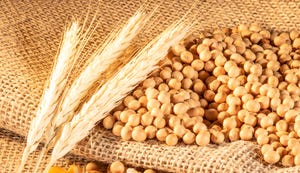March 1, 2009

First, there's the “wow” factor. Even in today's world of mega machinery, a 120-ft.-wide planter stops traffic and starts conversations. Large-scale operators want to know “how much?” Others shake their heads and ask, “Why?”
Regardless of the reaction, the DB120, the newest John Deere/Bauer Built planter, has 30% more productive capacity than Deere's DB90. It has the capacity to plant 90 to 100 acres/hr., or two sections of land in a long day.
It's not just big, it's high tech. “The DB120 is a front-fold, five-section flex-frame planter equipped with CCS Refuge Plus and Pro-Series XP row units,” says Rob Rippchen, Deere's division marketing manager for the new planter. “The planter will be offered with 125 bu. of seed capacity, SeedStar 2 monitoring and variable-rate seed drives, pneumatic down force, and RowCommand as standard equipment.” Front-mounted coulters or row cleaners are optional.
The DB120 is basically a stretched version of the DB90, with outside wings that are 30-ft. sections compared to the DB90's 15-ft. sections. It has the same width as the DB90 when folded, but measures 6 ft. longer when it's ready for road travel.
When it's empty, the DB120 crosses the scales at 40,200 lbs. Loaded with seed, the planter weighs roughly 47,700 lbs. To handle the increased weight and width, Vaughn Bauer of Bauer Built Manufacturing, who designed the toolbar and builds the planters in partnership with Deere, beefed up the telescoping tongue with larger tubing and added a second hydraulic blower for uniform seed distribution.
Availability of the John Deere DB120 will be limited in 2009, but the company will start taking orders this summer for farmers who want to plant with one in 2010. Retail price is $345,000.
“We have farmers who want to be on the front edge of new technology and they're excited about the planter,” says Brian Walker, general manager of Hogan Walker, a John Deere dealership in Somonauk, IL.
Walker views the DB120 as evolutionary, not revolutionary. “It's nice, but it won't change the industry the way GPS and precision farming technology have,” he says. “There are not too many customers for a 120-ft.-wide planter, whereas yield maps and autosteer have caused an industry change with a wide range of farmers.”
The DB120 will likely have the biggest effect on other equipment, according to Walker. “When one piece of equipment gets bigger, it affects other pieces of equipment getting bigger,” he says. “The DB120 sets the next size for combines and corn heads. You can't use a 16-row head on a crop planted with a 36-row planter and have them match up. With the 48-row planter, it fits with any corn head up to 16 rows.”
Farmers need to operate a minimum of 4,500 acres to justify a DB120, says Jay Adamson, sales manager for Van Wall Equipment, Perry, IA. One of his customers with 5,000 acres will use a DB120 this year to replace a DB90.
“Farmers interested in the DB120 are up-and-comers who want to get bigger and be innovative,” he says. “They've got a lot of acres or are trying to minimize their labor with bigger equipment.
“All the seed corn companies preach that you need to get your corn in early,” Adamson continues. “With the DB120 you get so much done in such a short amount of time. Guys who plant soybeans early also are seeing increased yields.”
Like Walker, Adamson sees a limited market for the DB120 in his Iowa marketing region. “We'll maybe sell one or two next year,” he says. “It will work well in square fields with flat, black soil. In Iowa, that means north of I-80.”
For more information, contact your local John Deere dealer, visit www.johndeere.com/ag or www.freeproduct info.net/fin, or circle 105.
About the Author(s)
You May Also Like




